HI6005 - Hofstede's Dimensions & the Myth of National Culture Explored
VerifiedAdded on 2023/06/12
|8
|1402
|281
Discussion Board Post
AI Summary
This assignment analyzes e-learning activities focusing on Hofstede's five dimensions of culture and the myth of national culture. It explores online tools for examining different countries through Hofstede's model, highlighting the importance of understanding cultural differences in a globalized world. The assignment also delves into Professor McSweeney's critique of national culture, contrasting it with Hofstede's survey-based generalizations. It questions the representativeness of Hofstede's data and the assumption of a shared national culture among individuals. The conclusion emphasizes the importance of cultural understanding and unity in diverse settings.
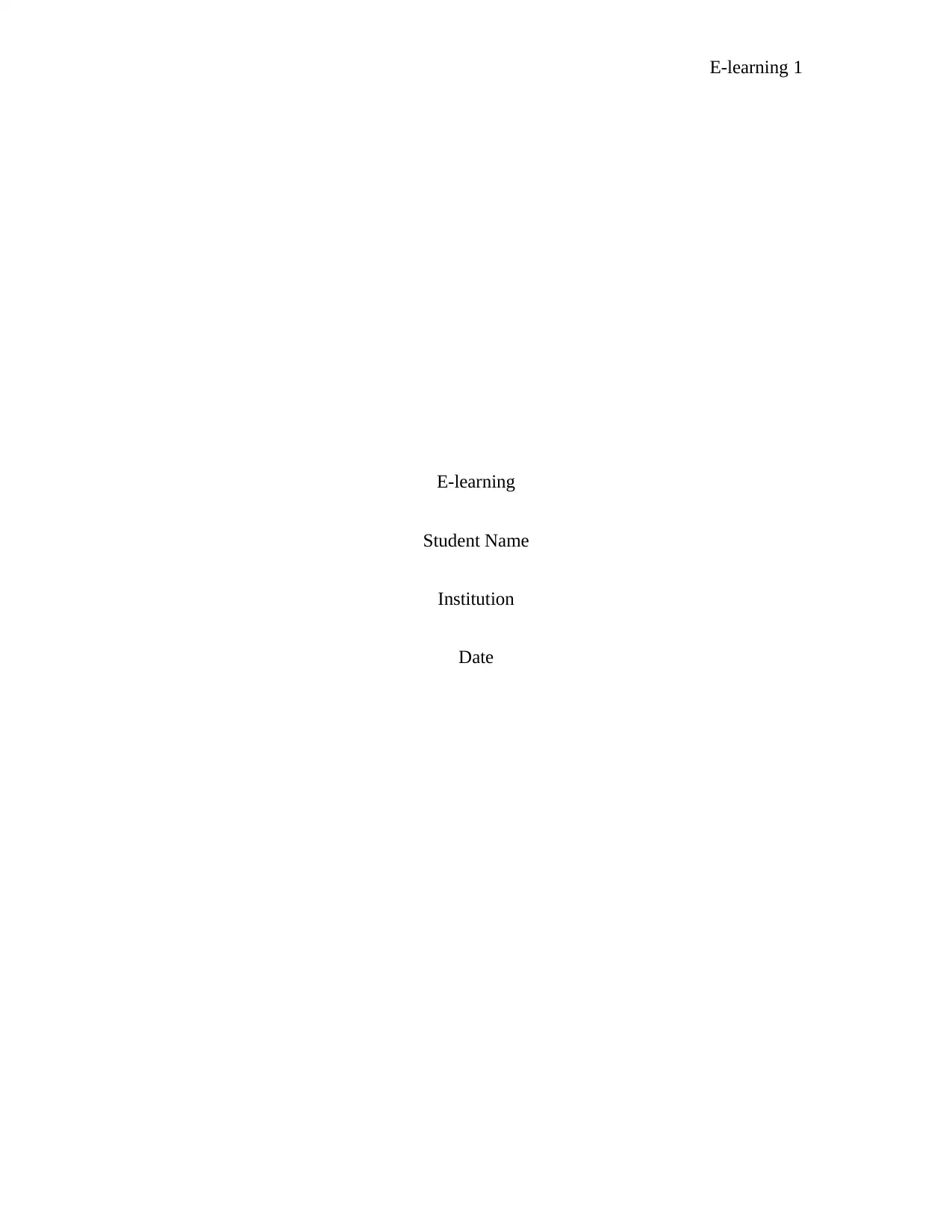
E-learning 1
E-learning
Student Name
Institution
Date
E-learning
Student Name
Institution
Date
Paraphrase This Document
Need a fresh take? Get an instant paraphrase of this document with our AI Paraphraser
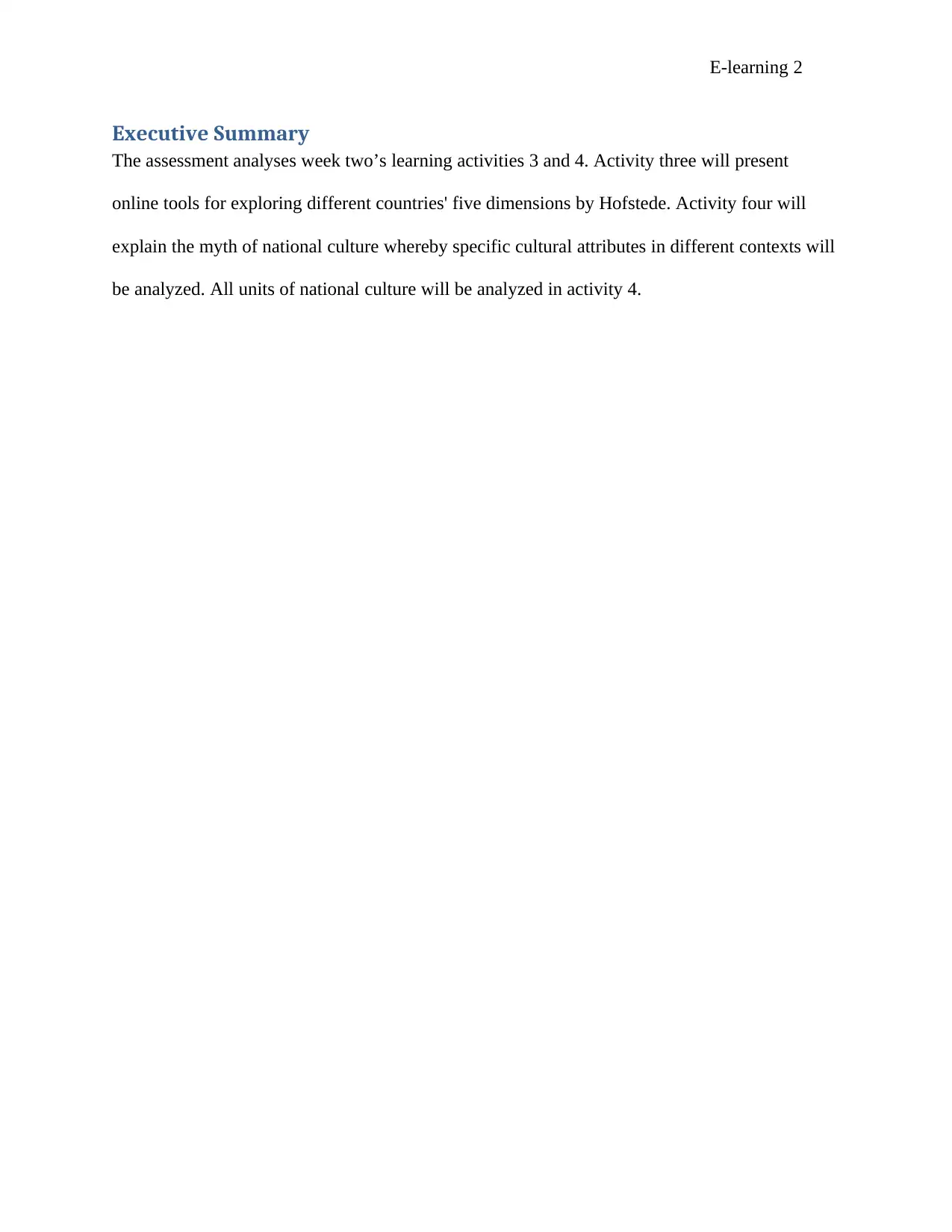
E-learning 2
Executive Summary
The assessment analyses week two’s learning activities 3 and 4. Activity three will present
online tools for exploring different countries' five dimensions by Hofstede. Activity four will
explain the myth of national culture whereby specific cultural attributes in different contexts will
be analyzed. All units of national culture will be analyzed in activity 4.
Executive Summary
The assessment analyses week two’s learning activities 3 and 4. Activity three will present
online tools for exploring different countries' five dimensions by Hofstede. Activity four will
explain the myth of national culture whereby specific cultural attributes in different contexts will
be analyzed. All units of national culture will be analyzed in activity 4.
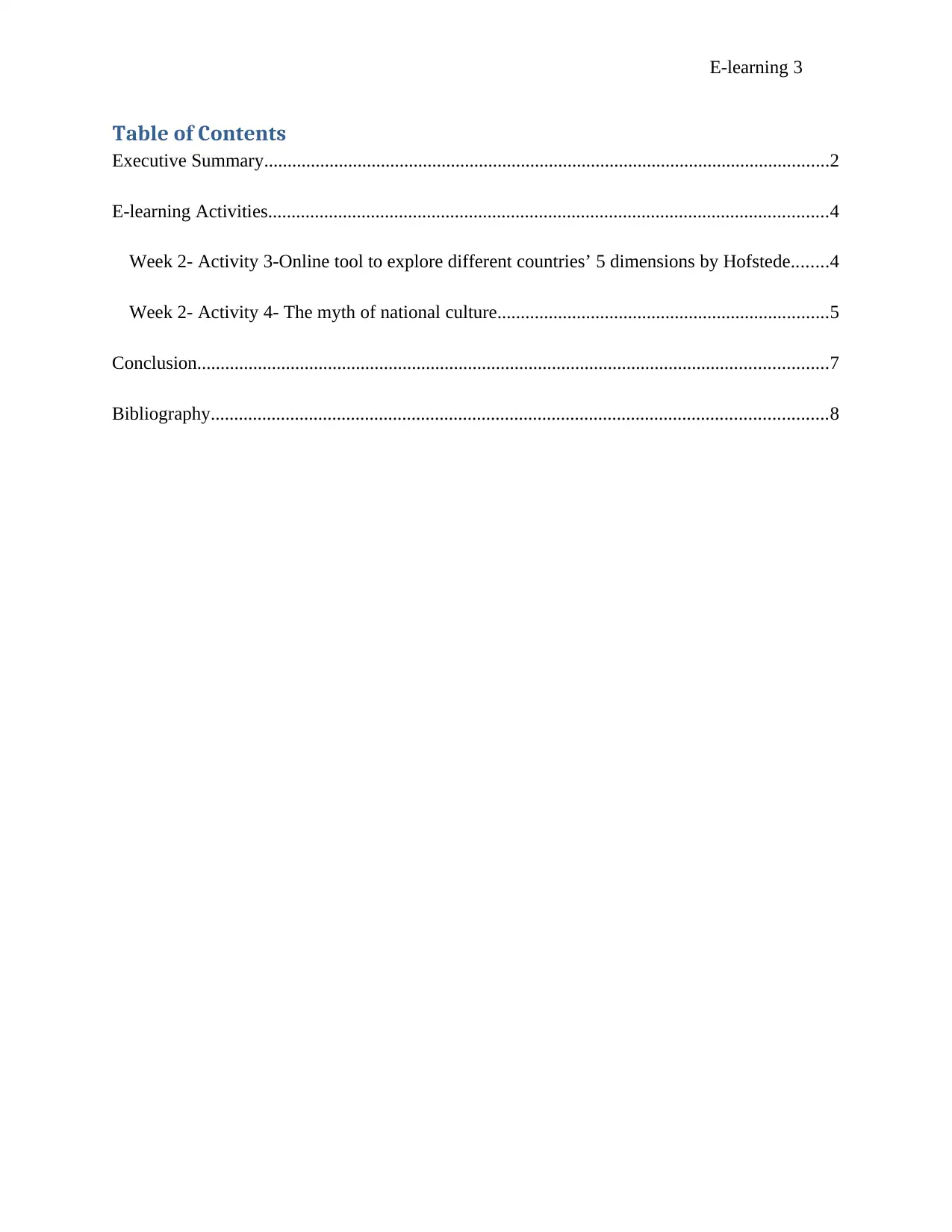
E-learning 3
Table of Contents
Executive Summary.........................................................................................................................2
E-learning Activities........................................................................................................................4
Week 2- Activity 3-Online tool to explore different countries’ 5 dimensions by Hofstede........4
Week 2- Activity 4- The myth of national culture.......................................................................5
Conclusion.......................................................................................................................................7
Bibliography....................................................................................................................................8
Table of Contents
Executive Summary.........................................................................................................................2
E-learning Activities........................................................................................................................4
Week 2- Activity 3-Online tool to explore different countries’ 5 dimensions by Hofstede........4
Week 2- Activity 4- The myth of national culture.......................................................................5
Conclusion.......................................................................................................................................7
Bibliography....................................................................................................................................8
⊘ This is a preview!⊘
Do you want full access?
Subscribe today to unlock all pages.

Trusted by 1+ million students worldwide
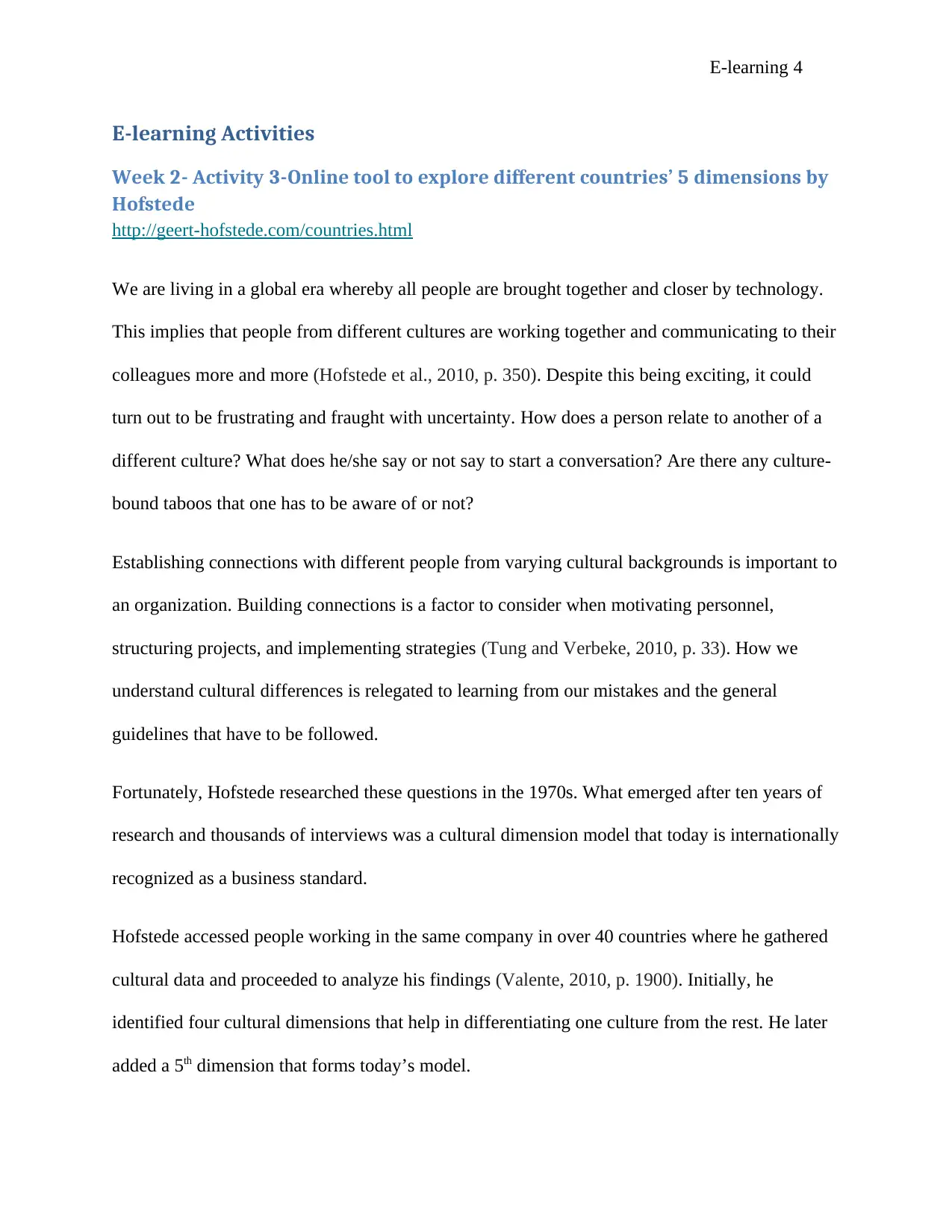
E-learning 4
E-learning Activities
Week 2- Activity 3-Online tool to explore different countries’ 5 dimensions by
Hofstede
http://geert-hofstede.com/countries.html
We are living in a global era whereby all people are brought together and closer by technology.
This implies that people from different cultures are working together and communicating to their
colleagues more and more (Hofstede et al., 2010, p. 350). Despite this being exciting, it could
turn out to be frustrating and fraught with uncertainty. How does a person relate to another of a
different culture? What does he/she say or not say to start a conversation? Are there any culture-
bound taboos that one has to be aware of or not?
Establishing connections with different people from varying cultural backgrounds is important to
an organization. Building connections is a factor to consider when motivating personnel,
structuring projects, and implementing strategies (Tung and Verbeke, 2010, p. 33). How we
understand cultural differences is relegated to learning from our mistakes and the general
guidelines that have to be followed.
Fortunately, Hofstede researched these questions in the 1970s. What emerged after ten years of
research and thousands of interviews was a cultural dimension model that today is internationally
recognized as a business standard.
Hofstede accessed people working in the same company in over 40 countries where he gathered
cultural data and proceeded to analyze his findings (Valente, 2010, p. 1900). Initially, he
identified four cultural dimensions that help in differentiating one culture from the rest. He later
added a 5th dimension that forms today’s model.
E-learning Activities
Week 2- Activity 3-Online tool to explore different countries’ 5 dimensions by
Hofstede
http://geert-hofstede.com/countries.html
We are living in a global era whereby all people are brought together and closer by technology.
This implies that people from different cultures are working together and communicating to their
colleagues more and more (Hofstede et al., 2010, p. 350). Despite this being exciting, it could
turn out to be frustrating and fraught with uncertainty. How does a person relate to another of a
different culture? What does he/she say or not say to start a conversation? Are there any culture-
bound taboos that one has to be aware of or not?
Establishing connections with different people from varying cultural backgrounds is important to
an organization. Building connections is a factor to consider when motivating personnel,
structuring projects, and implementing strategies (Tung and Verbeke, 2010, p. 33). How we
understand cultural differences is relegated to learning from our mistakes and the general
guidelines that have to be followed.
Fortunately, Hofstede researched these questions in the 1970s. What emerged after ten years of
research and thousands of interviews was a cultural dimension model that today is internationally
recognized as a business standard.
Hofstede accessed people working in the same company in over 40 countries where he gathered
cultural data and proceeded to analyze his findings (Valente, 2010, p. 1900). Initially, he
identified four cultural dimensions that help in differentiating one culture from the rest. He later
added a 5th dimension that forms today’s model.
Paraphrase This Document
Need a fresh take? Get an instant paraphrase of this document with our AI Paraphraser
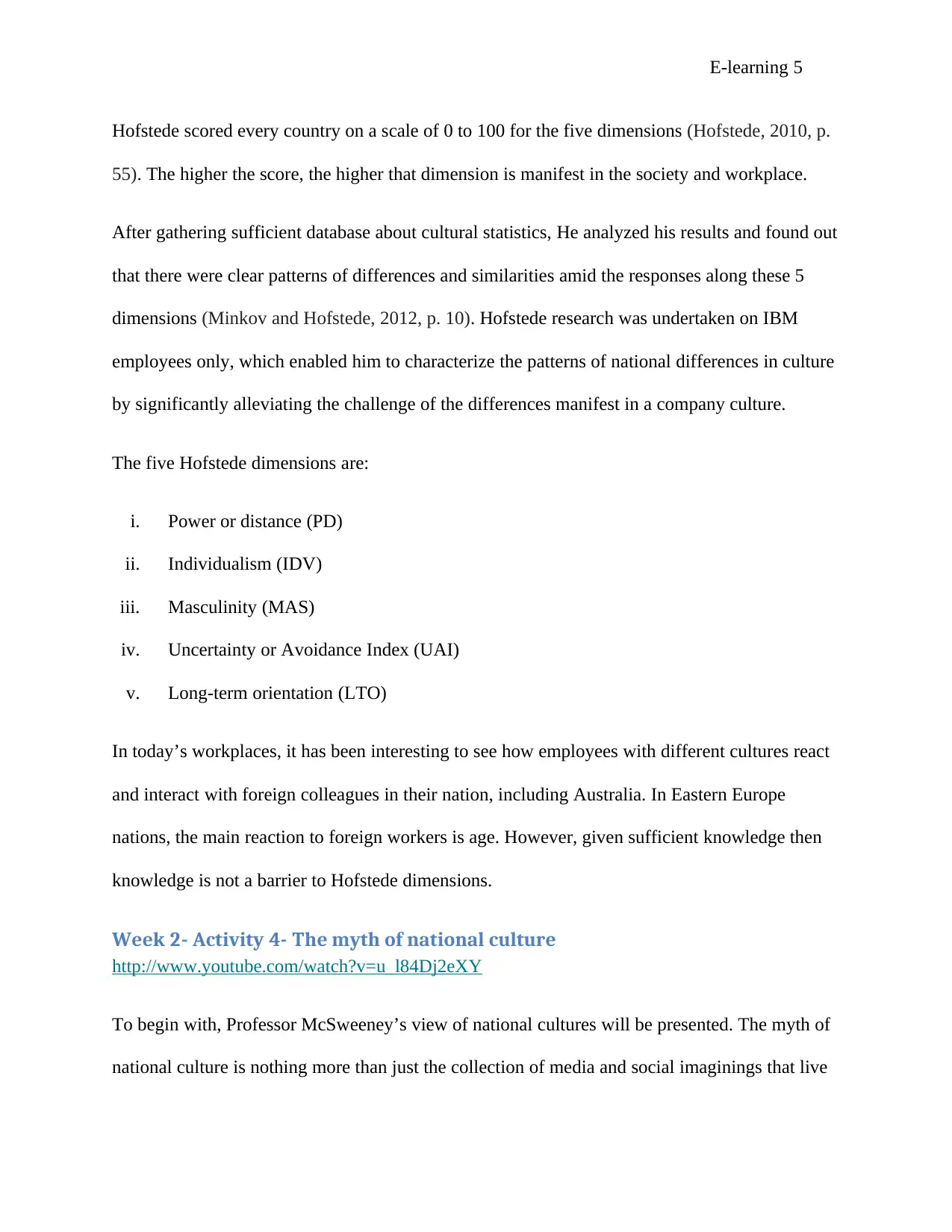
E-learning 5
Hofstede scored every country on a scale of 0 to 100 for the five dimensions (Hofstede, 2010, p.
55). The higher the score, the higher that dimension is manifest in the society and workplace.
After gathering sufficient database about cultural statistics, He analyzed his results and found out
that there were clear patterns of differences and similarities amid the responses along these 5
dimensions (Minkov and Hofstede, 2012, p. 10). Hofstede research was undertaken on IBM
employees only, which enabled him to characterize the patterns of national differences in culture
by significantly alleviating the challenge of the differences manifest in a company culture.
The five Hofstede dimensions are:
i. Power or distance (PD)
ii. Individualism (IDV)
iii. Masculinity (MAS)
iv. Uncertainty or Avoidance Index (UAI)
v. Long-term orientation (LTO)
In today’s workplaces, it has been interesting to see how employees with different cultures react
and interact with foreign colleagues in their nation, including Australia. In Eastern Europe
nations, the main reaction to foreign workers is age. However, given sufficient knowledge then
knowledge is not a barrier to Hofstede dimensions.
Week 2- Activity 4- The myth of national culture
http://www.youtube.com/watch?v=u_l84Dj2eXY
To begin with, Professor McSweeney’s view of national cultures will be presented. The myth of
national culture is nothing more than just the collection of media and social imaginings that live
Hofstede scored every country on a scale of 0 to 100 for the five dimensions (Hofstede, 2010, p.
55). The higher the score, the higher that dimension is manifest in the society and workplace.
After gathering sufficient database about cultural statistics, He analyzed his results and found out
that there were clear patterns of differences and similarities amid the responses along these 5
dimensions (Minkov and Hofstede, 2012, p. 10). Hofstede research was undertaken on IBM
employees only, which enabled him to characterize the patterns of national differences in culture
by significantly alleviating the challenge of the differences manifest in a company culture.
The five Hofstede dimensions are:
i. Power or distance (PD)
ii. Individualism (IDV)
iii. Masculinity (MAS)
iv. Uncertainty or Avoidance Index (UAI)
v. Long-term orientation (LTO)
In today’s workplaces, it has been interesting to see how employees with different cultures react
and interact with foreign colleagues in their nation, including Australia. In Eastern Europe
nations, the main reaction to foreign workers is age. However, given sufficient knowledge then
knowledge is not a barrier to Hofstede dimensions.
Week 2- Activity 4- The myth of national culture
http://www.youtube.com/watch?v=u_l84Dj2eXY
To begin with, Professor McSweeney’s view of national cultures will be presented. The myth of
national culture is nothing more than just the collection of media and social imaginings that live
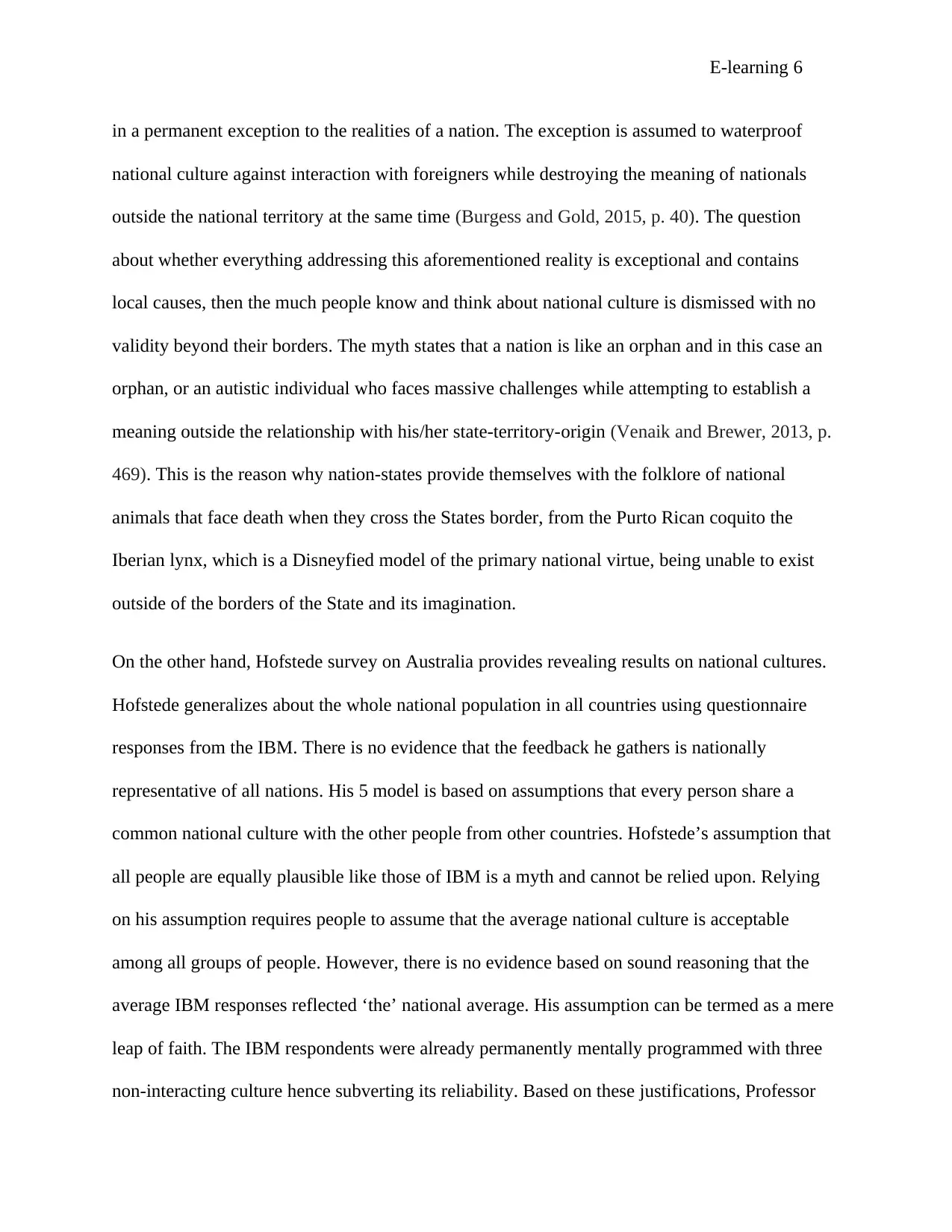
E-learning 6
in a permanent exception to the realities of a nation. The exception is assumed to waterproof
national culture against interaction with foreigners while destroying the meaning of nationals
outside the national territory at the same time (Burgess and Gold, 2015, p. 40). The question
about whether everything addressing this aforementioned reality is exceptional and contains
local causes, then the much people know and think about national culture is dismissed with no
validity beyond their borders. The myth states that a nation is like an orphan and in this case an
orphan, or an autistic individual who faces massive challenges while attempting to establish a
meaning outside the relationship with his/her state-territory-origin (Venaik and Brewer, 2013, p.
469). This is the reason why nation-states provide themselves with the folklore of national
animals that face death when they cross the States border, from the Purto Rican coquito the
Iberian lynx, which is a Disneyfied model of the primary national virtue, being unable to exist
outside of the borders of the State and its imagination.
On the other hand, Hofstede survey on Australia provides revealing results on national cultures.
Hofstede generalizes about the whole national population in all countries using questionnaire
responses from the IBM. There is no evidence that the feedback he gathers is nationally
representative of all nations. His 5 model is based on assumptions that every person share a
common national culture with the other people from other countries. Hofstede’s assumption that
all people are equally plausible like those of IBM is a myth and cannot be relied upon. Relying
on his assumption requires people to assume that the average national culture is acceptable
among all groups of people. However, there is no evidence based on sound reasoning that the
average IBM responses reflected ‘the’ national average. His assumption can be termed as a mere
leap of faith. The IBM respondents were already permanently mentally programmed with three
non-interacting culture hence subverting its reliability. Based on these justifications, Professor
in a permanent exception to the realities of a nation. The exception is assumed to waterproof
national culture against interaction with foreigners while destroying the meaning of nationals
outside the national territory at the same time (Burgess and Gold, 2015, p. 40). The question
about whether everything addressing this aforementioned reality is exceptional and contains
local causes, then the much people know and think about national culture is dismissed with no
validity beyond their borders. The myth states that a nation is like an orphan and in this case an
orphan, or an autistic individual who faces massive challenges while attempting to establish a
meaning outside the relationship with his/her state-territory-origin (Venaik and Brewer, 2013, p.
469). This is the reason why nation-states provide themselves with the folklore of national
animals that face death when they cross the States border, from the Purto Rican coquito the
Iberian lynx, which is a Disneyfied model of the primary national virtue, being unable to exist
outside of the borders of the State and its imagination.
On the other hand, Hofstede survey on Australia provides revealing results on national cultures.
Hofstede generalizes about the whole national population in all countries using questionnaire
responses from the IBM. There is no evidence that the feedback he gathers is nationally
representative of all nations. His 5 model is based on assumptions that every person share a
common national culture with the other people from other countries. Hofstede’s assumption that
all people are equally plausible like those of IBM is a myth and cannot be relied upon. Relying
on his assumption requires people to assume that the average national culture is acceptable
among all groups of people. However, there is no evidence based on sound reasoning that the
average IBM responses reflected ‘the’ national average. His assumption can be termed as a mere
leap of faith. The IBM respondents were already permanently mentally programmed with three
non-interacting culture hence subverting its reliability. Based on these justifications, Professor
⊘ This is a preview!⊘
Do you want full access?
Subscribe today to unlock all pages.

Trusted by 1+ million students worldwide
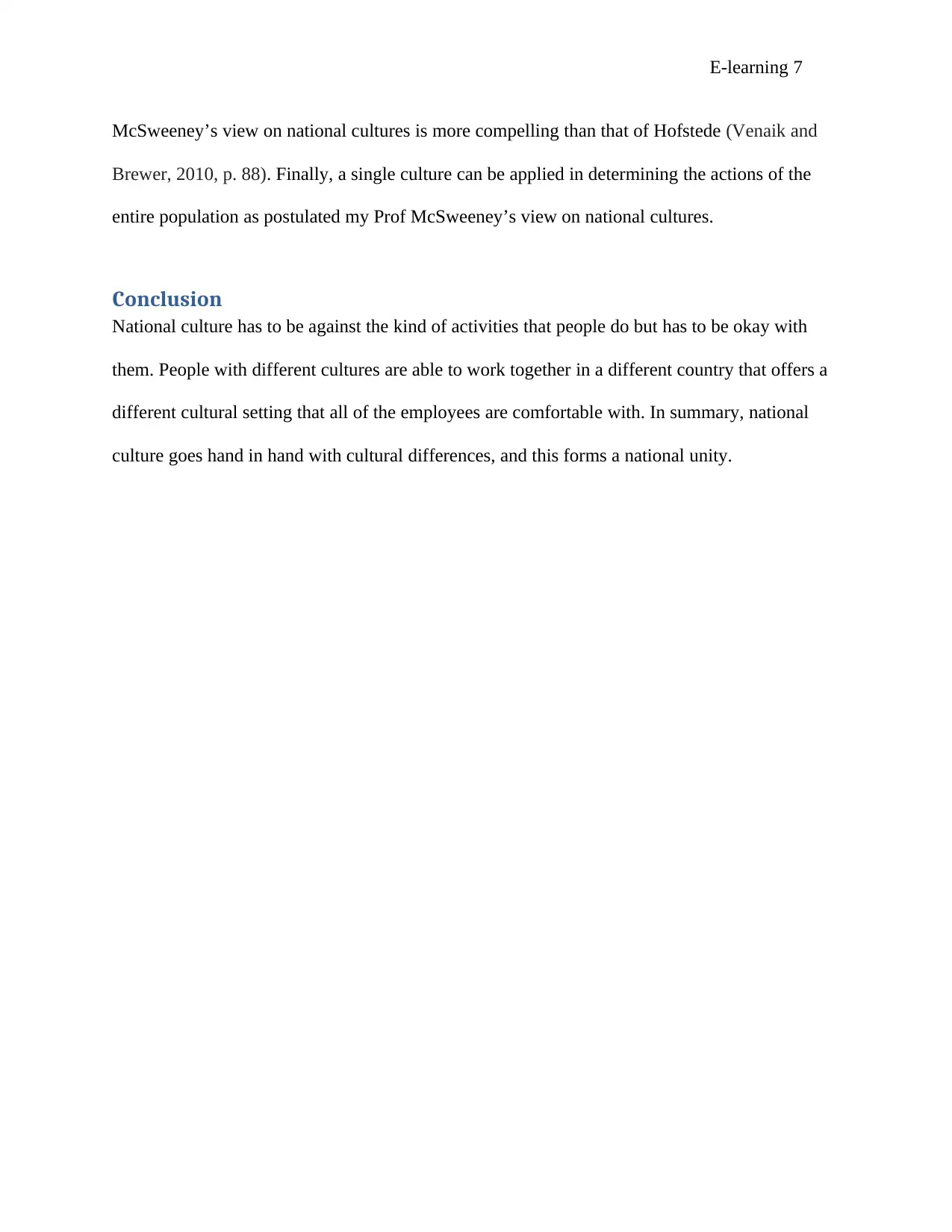
E-learning 7
McSweeney’s view on national cultures is more compelling than that of Hofstede (Venaik and
Brewer, 2010, p. 88). Finally, a single culture can be applied in determining the actions of the
entire population as postulated my Prof McSweeney’s view on national cultures.
Conclusion
National culture has to be against the kind of activities that people do but has to be okay with
them. People with different cultures are able to work together in a different country that offers a
different cultural setting that all of the employees are comfortable with. In summary, national
culture goes hand in hand with cultural differences, and this forms a national unity.
McSweeney’s view on national cultures is more compelling than that of Hofstede (Venaik and
Brewer, 2010, p. 88). Finally, a single culture can be applied in determining the actions of the
entire population as postulated my Prof McSweeney’s view on national cultures.
Conclusion
National culture has to be against the kind of activities that people do but has to be okay with
them. People with different cultures are able to work together in a different country that offers a
different cultural setting that all of the employees are comfortable with. In summary, national
culture goes hand in hand with cultural differences, and this forms a national unity.
Paraphrase This Document
Need a fresh take? Get an instant paraphrase of this document with our AI Paraphraser
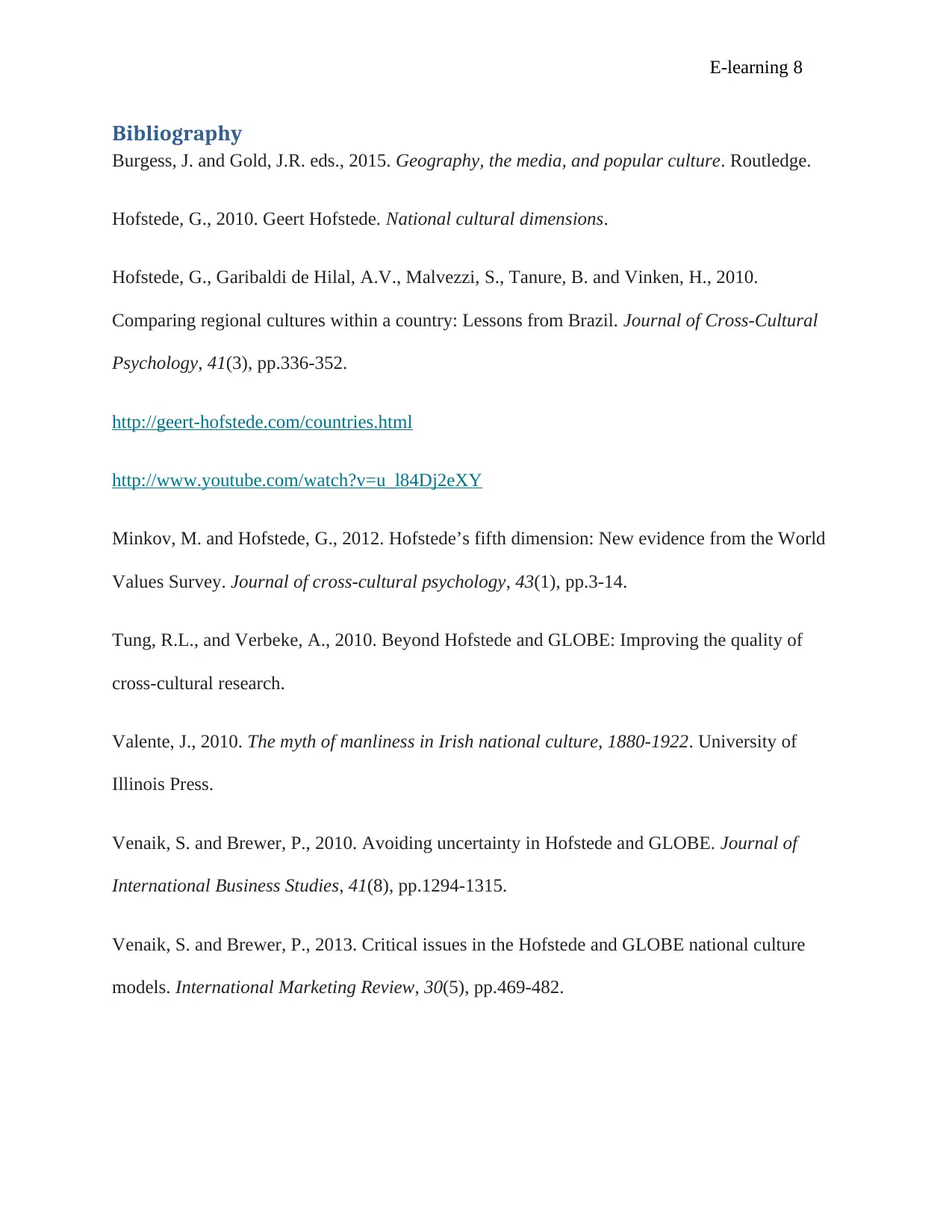
E-learning 8
Bibliography
Burgess, J. and Gold, J.R. eds., 2015. Geography, the media, and popular culture. Routledge.
Hofstede, G., 2010. Geert Hofstede. National cultural dimensions.
Hofstede, G., Garibaldi de Hilal, A.V., Malvezzi, S., Tanure, B. and Vinken, H., 2010.
Comparing regional cultures within a country: Lessons from Brazil. Journal of Cross-Cultural
Psychology, 41(3), pp.336-352.
http://geert-hofstede.com/countries.html
http://www.youtube.com/watch?v=u_l84Dj2eXY
Minkov, M. and Hofstede, G., 2012. Hofstede’s fifth dimension: New evidence from the World
Values Survey. Journal of cross-cultural psychology, 43(1), pp.3-14.
Tung, R.L., and Verbeke, A., 2010. Beyond Hofstede and GLOBE: Improving the quality of
cross-cultural research.
Valente, J., 2010. The myth of manliness in Irish national culture, 1880-1922. University of
Illinois Press.
Venaik, S. and Brewer, P., 2010. Avoiding uncertainty in Hofstede and GLOBE. Journal of
International Business Studies, 41(8), pp.1294-1315.
Venaik, S. and Brewer, P., 2013. Critical issues in the Hofstede and GLOBE national culture
models. International Marketing Review, 30(5), pp.469-482.
Bibliography
Burgess, J. and Gold, J.R. eds., 2015. Geography, the media, and popular culture. Routledge.
Hofstede, G., 2010. Geert Hofstede. National cultural dimensions.
Hofstede, G., Garibaldi de Hilal, A.V., Malvezzi, S., Tanure, B. and Vinken, H., 2010.
Comparing regional cultures within a country: Lessons from Brazil. Journal of Cross-Cultural
Psychology, 41(3), pp.336-352.
http://geert-hofstede.com/countries.html
http://www.youtube.com/watch?v=u_l84Dj2eXY
Minkov, M. and Hofstede, G., 2012. Hofstede’s fifth dimension: New evidence from the World
Values Survey. Journal of cross-cultural psychology, 43(1), pp.3-14.
Tung, R.L., and Verbeke, A., 2010. Beyond Hofstede and GLOBE: Improving the quality of
cross-cultural research.
Valente, J., 2010. The myth of manliness in Irish national culture, 1880-1922. University of
Illinois Press.
Venaik, S. and Brewer, P., 2010. Avoiding uncertainty in Hofstede and GLOBE. Journal of
International Business Studies, 41(8), pp.1294-1315.
Venaik, S. and Brewer, P., 2013. Critical issues in the Hofstede and GLOBE national culture
models. International Marketing Review, 30(5), pp.469-482.
1 out of 8
Related Documents
Your All-in-One AI-Powered Toolkit for Academic Success.
+13062052269
info@desklib.com
Available 24*7 on WhatsApp / Email
![[object Object]](/_next/static/media/star-bottom.7253800d.svg)
Unlock your academic potential
Copyright © 2020–2025 A2Z Services. All Rights Reserved. Developed and managed by ZUCOL.





